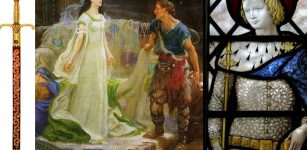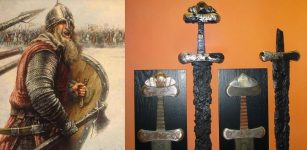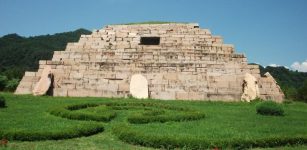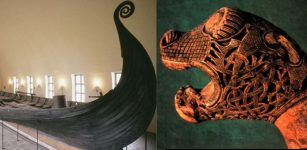Gefjon: Norse Fertility Goddess Who Knew Humans’ Fates, And Plowed Away Part Of Sweden To Give It To Denmark
A. Sutherland - AncientPages.com - Gefjon (Gefion) was the Aesir goddess of fertility, plow, and agriculture in Norse mythology. She also possessed extraordinary mental abilities, and just like Frigg, she knew the secrets of human fates.
The goddess Gefjun plows up Zealand with her oxen sons. Author: Carl Ehrenberg (1840–1914). Public Domain
According to the Prose Edda, she was one of the maidens in the palace of Frigga (Frigg) ("the beloved"), who, in Nordic mythology, was the queen of the gods, Asgard's mistress, the wife of Odin, mother of Balder, and stepmother of Hermod, Vidar and Höder.
Gefjon, a beautiful goddess of the Æsir, had many maidservants; all maidens who died unwedded were entrusted to her. It happened when Gefjon lived in Jotunheim, the country of legendary giants located in the very north of Europe. According to some authors, Gefjon did not remain a virgin forever but married one of the giants, and she had four sons with him.
Today, this region is known as the land of the Sami people.
Gefjon, Disguised As A Beggar Tricked The King Of Sweden
In 'Gylfaginning' by Snorri Sturluson, there is a story about Gefjon, who disguised herself as a beggar. Tradition has it that Odin, who dwelled on the island of Odense, sent Gefjon to visit Gylfi, King of Sweden, and to beg him for some land that she might call her own.
Amused at her unusual request, the king promised her as much land as she could plow in one day and night. He did not believe that she could take much land during such a short time, but he was wrong.
 Promenade at Gefjon Fountain was painted by Paul Fischer (1860-1934). source
Promenade at Gefjon Fountain was painted by Paul Fischer (1860-1934). source
In this story, Gefjon is not only a beggar but also an older woman. She needed as much help as possible, so she went up to the mountains and transformed her sons into oxen. They worked hard, plowing up a large part of Gylfe's kingdom. The plow in Sweden's western - flat and fertile region - went deep into the ground and cut out a vast amount of the Swedish territory.
When she and her oxen were ready, they dragged this enormous piece of land down into the sea, where the goddess Gefjon formed a wonderful fertile island that belonged to Denmark. Gefjon gave it a name: Sjælland (Zealand).
There, Gefjon made her home and married Odin's son Skjold (Skiold or Scyld), with whom she lived in the city of Hleidra (or Lethra). She is considered the ancestress of the Danish royal race of Skioldungs. It is said that a noble line of kings and skilled warriors descended from them.
The excavated area created a "hole" in the Swedish soil, which was quickly filled with water, forming a large lake, at first called Logrum (the sea) but was later known as Mälaren (some versions refer to Lake Vänern, located in the southwest of Sweden).
Gefjon Visits King Gylfi Of Sweden
One of them says that Gefjon loved to wander the world. Once, she was invited to visit king Gylfi in Sweden, who wanted to meet the beautiful Gefjon. Together with king Gylfi, she had a pleasant time.
 The Gefion Fountain (Gefionspringvandet), located in Langelinje Park, Copenhagen, Denmark. The large stones symbolize the land plowed by the goddess Gefjon and her four oxen. source
The Gefion Fountain (Gefionspringvandet), located in Langelinje Park, Copenhagen, Denmark. The large stones symbolize the land plowed by the goddess Gefjon and her four oxen. source
Then, he wanted to thank her royally, so he said he would give her as much land as she would plow in one day and one night. Gylfi did not believe Gefjon could get much land during such a short time of plowing.
As we learned, the clever goddess Gefjon surprised him.
Loki Insults Goddess Gefjon At Ægir's Feast
Usually, Loki either assists the gods or misbehaves towards them. His evil side is seen in the poem 'Lokasenna' (Old Norse "Loki's Quarrel"), an Old West Nordic poem in the Poetic Edda recorded in Codex Regius. The poem presents an exchange of insults between the gods and Loki.
Loki, amongst other things, accuses the gods of moralistic sexual impropriety, the practice of sorcery, and prejudice.
In 'Lokasenna,' Loki once again shows his true nature, but this time, he is involved in the exchange of insults addressed to the goddess Gefjon.
Odin at once warns Loki to beware of Gefjon's wrath, "for she knows the destinies of men as well as I."
Gefjon Did Almost Exactly In The Same Way As Dido Of Carthage
The story of Gefjon and the clever way she procured land from Gylfi to form her kingdom of Seeland (Zealand) is much like the Greek story of Dido, who obtained by stratagem the land upon which she founded her city of Carthage.
Dido asked Iarbus, the Berber ruler if she could buy some piece of land to settle and start a new life with her people.
In both accounts, oxen play an essential role. For a while in the Northern myth, these sturdy animals draw the piece of land far out to sea. On the other, Dido, a brilliant woman, instructed her people to cut the animal's skin into skinny strips. Then, her people covered the piece of land with stripes, and thus, they marked its borders.
Written by – A. Sutherland - AncientPages.com Senior Staff Writer
Updated on October 17, 2022
Copyright © AncientPages.com All rights reserved. This material may not be published, broadcast, rewritten or redistributed in whole or part without the express written permission of AncientPages.com
Expand for referencesReferences:
Anders Baeksted, Nordiska Gudar och Hjältar
Sturluson S. Prose Edda
http://www.hovedstadshistorie.dk/
Belton J, An Encyclopedia of Norse Mythology
More From Ancient Pages
-
 On This Day In History: Thomas Cromwell Arrested In Westminster – On June 10, 1540
News | Jun 10, 2016
On This Day In History: Thomas Cromwell Arrested In Westminster – On June 10, 1540
News | Jun 10, 2016 -
 Gnomes – Fantastic Supernatural Creatures Knowing Secrets Of Earth Mountains Rivers And Rocks
Featured Stories | Nov 20, 2018
Gnomes – Fantastic Supernatural Creatures Knowing Secrets Of Earth Mountains Rivers And Rocks
Featured Stories | Nov 20, 2018 -
 Neanderthals And Homo Sapiens Invented Different Fire Techniques – Evolution Of Human Cognition
Archaeology | Jun 1, 2023
Neanderthals And Homo Sapiens Invented Different Fire Techniques – Evolution Of Human Cognition
Archaeology | Jun 1, 2023 -
 3D Reconstruction Of ‘Lost Chapel’ Of Westminster Palace
Archaeology | Oct 9, 2017
3D Reconstruction Of ‘Lost Chapel’ Of Westminster Palace
Archaeology | Oct 9, 2017 -
 Mysterious Ancient Grave With Unusual Artifacts That Belonged To A Völva – Norse Female Shamans Did Exist
Featured Stories | Jul 2, 2017
Mysterious Ancient Grave With Unusual Artifacts That Belonged To A Völva – Norse Female Shamans Did Exist
Featured Stories | Jul 2, 2017 -
 Location of Roman Ballista Machines During The Siege Of Jerusalem – Uncovered
Archaeology | Aug 17, 2022
Location of Roman Ballista Machines During The Siege Of Jerusalem – Uncovered
Archaeology | Aug 17, 2022 -
 168 Unknown Geoglyphs Discovered In The Nazca Desert By Drones
Archaeology | Dec 19, 2022
168 Unknown Geoglyphs Discovered In The Nazca Desert By Drones
Archaeology | Dec 19, 2022 -
 On This Day In History: Amelia Earhart, Most Famous Female Pilot – Disappeared Over The Pacific Ocean – On July 2, 1937
News | Jul 2, 2016
On This Day In History: Amelia Earhart, Most Famous Female Pilot – Disappeared Over The Pacific Ocean – On July 2, 1937
News | Jul 2, 2016 -
 Ancient Maya Stela Carved On Both Sides Unearthed ‘In Situ’ In Uxmal, Yucatan Peninsula
Archaeology | Oct 31, 2022
Ancient Maya Stela Carved On Both Sides Unearthed ‘In Situ’ In Uxmal, Yucatan Peninsula
Archaeology | Oct 31, 2022 -
 7,000-Year-Old Unique Lipnik Idol Statuette Unearthed In Moravian Gate Valley, Czech Republic
Archaeology | Dec 14, 2015
7,000-Year-Old Unique Lipnik Idol Statuette Unearthed In Moravian Gate Valley, Czech Republic
Archaeology | Dec 14, 2015 -
 Mysterious Camerano Underground City – Secret Meeting Place For Knights Templar?
Featured Stories | Dec 13, 2017
Mysterious Camerano Underground City – Secret Meeting Place For Knights Templar?
Featured Stories | Dec 13, 2017 -
 Curtana – Sword Of Mercy Once Belonged To The Anglo-Saxon King Edward The Confessor And Perhaps Even The Arthurian Hero Tristan
Artifacts | Jul 16, 2017
Curtana – Sword Of Mercy Once Belonged To The Anglo-Saxon King Edward The Confessor And Perhaps Even The Arthurian Hero Tristan
Artifacts | Jul 16, 2017 -
 Mystery Of The Coal On The Pirate Shipwreck Queen Anne’s Revenge Solved
Archaeology | Apr 13, 2023
Mystery Of The Coal On The Pirate Shipwreck Queen Anne’s Revenge Solved
Archaeology | Apr 13, 2023 -
 Vikings Visited America 1,000 Years Ago – Solar Storm And Archaeology Confirm Icelandic Sagas
Archaeology | Oct 22, 2021
Vikings Visited America 1,000 Years Ago – Solar Storm And Archaeology Confirm Icelandic Sagas
Archaeology | Oct 22, 2021 -
 Location Of Elusive Spanish Fort Is Now Verified By Florida And Georgia Archaeologists
Archaeology | Apr 24, 2020
Location Of Elusive Spanish Fort Is Now Verified By Florida And Georgia Archaeologists
Archaeology | Apr 24, 2020 -
 Why Did Vikings Carry Decorative Swords That Were Useless In Combat?
Ancient History Facts | Dec 19, 2017
Why Did Vikings Carry Decorative Swords That Were Useless In Combat?
Ancient History Facts | Dec 19, 2017 -
 Child’s Play: Are Tibetan Hand And Foot Traces The Earliest Example Of Parietal Art?
Archaeology | Sep 18, 2021
Child’s Play: Are Tibetan Hand And Foot Traces The Earliest Example Of Parietal Art?
Archaeology | Sep 18, 2021 -
 Complex Of Goguryeo Tombs: Beautiful Ancient Wall Paintings Displaying History And Mythology Of North Korea
Civilizations | Oct 19, 2018
Complex Of Goguryeo Tombs: Beautiful Ancient Wall Paintings Displaying History And Mythology Of North Korea
Civilizations | Oct 19, 2018 -
 Indus Valley Civilization Far Ahead Of Its Time Has Baffled Scientists For Centuries
Ancient Technology | May 18, 2017
Indus Valley Civilization Far Ahead Of Its Time Has Baffled Scientists For Centuries
Ancient Technology | May 18, 2017 -
 Oseberg Ship: Amazingly Well-Preserved Viking Burial Ship
Featured Stories | Jun 15, 2016
Oseberg Ship: Amazingly Well-Preserved Viking Burial Ship
Featured Stories | Jun 15, 2016

